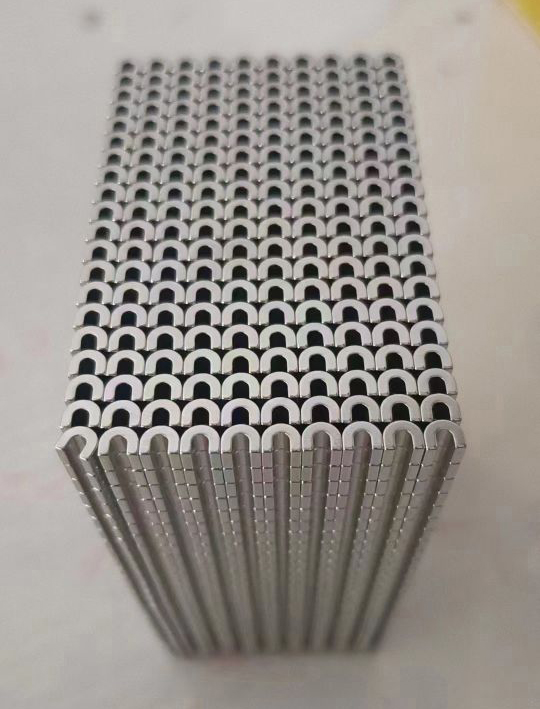Unwittingly, it has already arrived at the end of July. I believe that you may have harvested many long-awaited returns in July. Today daisy brings you a "horseshoe magnet", which is a kind of permanent magnet that we often see on TV before we even enter the magnet industry.Today we will bring you the meaning, history, work princeple and uses(application) of the horseshoe magnet.
What is horseshoe magnets?
A horseshoe magnet is a magnetic material used to make magnets. This material is shaped like a horseshoe, so it is called a horseshoe strong magnet. It is an alloy of metals such as cobalt and neodymium. It gets its name because it is shaped like a hoof on a horse's foot. Its shape is also like the English letter U, also known as U-shaped magnet. Its surface is usually painted red, blue, or half red and half blue and labeled "North Pole" and "South Pole". Despite being phased out in the 1950s by squat, cylindrical magnets made of modern materials, horseshoe magnets still frequently appear in elementary school textbooks. Historically, they solved the problem of creating compact magnets that would not self-destruct in their own demagnetizing field.
Horseshoe magnet has many excellent physical properties, such as high coercivity, low remanence, high remanence strength and high Curie point. Good thermal stability and corrosion resistance at room temperature; It also has high resistivity and low temperature coefficient and so on.
The picture is a neodymium powerful horseshoe U-shaped magnet

The history of horseshoe magnets:
Early 19th century, it was found that by a piece of metal of current makes the compass deflection. After this discovery, many experiments on magnetism were carried out.
Sturgeon created the first electromagnet in 1821 by wrapping a wire around a U-shaped piece of iron and testing it with electricity, the first magnet strong enough to lift a magnetic object heavier than its own weight. After testing and experimenting with the U-shaped magnet, Sturgeon was able to identify that it had a stronger pull than a traditional bar magnet because the horseshoe magnet brought the poles closer together, creating a more concentrated magnetic field.
It is also the first practical electromagnet, and the first can lift than bigger objects magnets, magnet itself was a 7 oz magnet can lift nine pounds of iron. Sturgeon showed that he could adjust the magnetic field of a horseshoe magnet by increasing or decreasing the current passing through a wire.This would set the stage for the development of the telegraph and the future of global telecommunications in the next century and beyond.
In more modern times, what we see is basically a horseshoe magnet made of aluminum-nickel-cobalt and ferrite, but no neodymium, because it already has a strong pulling force and high coercivity. Aluminum nickel cobalt and ferrite are materials that benefit from increased tension and demagnetization.
The working principle of the horseshoe magnet:
Because of its raw material composition, a horseshoe magnet is called a permanent magnet, which constantly generates a magnetic field in and around itself. Like all magnets in the world, horseshoe magnets have two magnetic poles. Its north and south poles exert a strong gravitational pull on objects made of ferromagnetic materials such as iron, cobalt and nickel. When iron and a magnet are close together, the basic composition of iron corresponds to the magnetic pole of the magnet. Thus, the South Pole of each iron atom is close to the North Pole of the magnet, and the North Pole is close to the South Pole of the magnet. This effect is visible and noticeable on these objects in the form of magnetic attraction.
This phenomenon is due to the atomic structure of the metal. Because of spin, the movement of electrons around the nucleus, each iron particle has the properties of a tiny electromagnet. Each atom has its own north and South Pole.
The uses of horseshoe magnet:
Horseshoe magnets have a wide range of applications, from scientific experiments and picking up paper clips to lifting heavy objects in buildings (with industrial-size magnets).
It is usually used to pick up heavy iron or magnetic metal objects of various sizes and weights, depending on the strength of the horseshoe magnet. For example, small horseshoes can collect paper clips, while industrial-size horseshoe magnets are used in construction and engineering to absorb large pieces of heavy metals.
Teaching equipment. Horseshoe magnets are best used in physics classes to show students that magnets have two poles: north and south.
Motor. In everyday life, horseshoe magnets are used in generators and motors (such as cars). These motors are simpler because they do not require an exciting coil.
The above is an introduction to the significance, historical origin, working principle and use of horseshoe magnets. In fact, the horseshoe magnet has a very variety of shapes, not necessarily really like the ancient horseshoe assembly of iron is called the horseshoe magnet, the existing horseshoe magnet and ring, rectangular and so on.
Hope this content can provide you with useful information, our factory can also customize the horseshoe magnet at present. If you need, you can contact us!
Related product cases;
U Shaped Horseshoe Industrial Strong Magnet [Custom Wholesale]
 China Neodymium And Ferrite Magnets Manufacturer & Supplier
China Neodymium And Ferrite Magnets Manufacturer & Supplier 


